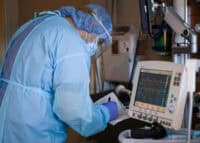
At one point, not terribly long ago, the picture of doctors was people who had spent endless years getting educations, made a great deal of money and took every Wednesday off. Whether that is true or not now, the life of a doctor can be grueling. The COVID-19 pandemic has robbed thousands of doctors of their practices. Many of these worked in specialties in which people had to come to offices to be examined or have surgery that was elective. Without “rainy day” funds to bridge them over these months, the costs to practice became overwhelming.
The lives of other doctors became challenging as they treated tens of thousands of people in hospitals, particularly in cities where the COVID-19 pandemic caused a huge influx of extremely sick patients, some of whom died. Some of these physicians worked endless hours. Others became infected themselves.
“Burn out” is defined as a condition in which people become so ill or exhausted from their work that they cannot function. Medscape’s recently released its Physician Burnout & Depression Report 2022: Stress, Anxiety, and Anger report. The study questioned 13,000 doctors in 29 specialties between June 29 and September 26 last year. According to a Becker’s Healthcare article on the Medscape study, “Across all specialties, 47 percent reported feeling burned out last year.”
The list was topped by emergency room doctors at 60%, followed by critical care doctors at 56%. Each of these specialties had many doctors on the front lines of treating patients with COVID-19 infections. At the far end of the list, public health and preventative medicine doctors posted a figure of 26%.
These are the 20 specialties where doctors are most likely to report burnout:
- Emergency Medicine (60%)
- Critical Care (56%)
- Ob/Gyn (53%)
- Infectious Diseases (51%)
- Family Medicine (51%)
- Physical Medicine and Rehabilitation (50%)
- Diabetes and Endocrinology (50%)
- Radiology (49%)
- Pediatrics (49%)
- Pulmonary Medicine (48%)
- Gastroenterology (48%)
- Internal Medicine (48%)
- Urology (48%)
- Anesthesiology (47%)
- Rheumatology (46%)
- Neurology (46%)
- Surgery, General (44%)
- Cardiology (42%)
- Allergy & Immunology (42%)
- Nephrology (40%)
- Plastic Surgery (40%)
- Ophthalmology (40%)
- Psychiatry (38%)
- Otolaryngology (37%)
- Orthopedics (37%)
- Oncology (36%)
- Pathology (35%)
- Dermatology (33%)
- Public Health & Preventative Medicine (26%)
Click here to read about the highest paid doctors in America.
Travel Cards Are Getting Too Good To Ignore (sponsored)
Credit card companies are pulling out all the stops, with the issuers are offering insane travel rewards and perks.
We’re talking huge sign-up bonuses, points on every purchase, and benefits like lounge access, travel credits, and free hotel nights. For travelers, these rewards can add up to thousands of dollars in flights, upgrades, and luxury experiences every year.
It’s like getting paid to travel — and it’s available to qualified borrowers who know where to look.
We’ve rounded up some of the best travel credit cards on the market. Click here to see the list. Don’t miss these offers — they won’t be this good forever.
Thank you for reading! Have some feedback for us?
Contact the 24/7 Wall St. editorial team.



